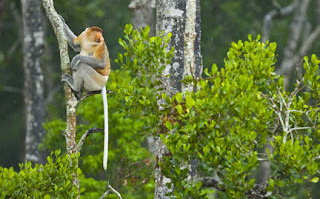This species has a distictive long nose which helped to give it it's name. Today, we have the Proboscis Monkey. This species of leaf-eating monkeys is an excellent swimmer, with a nose that is noticable ever since they were infants.
The proboscis monkey has a red "crown" of fur on the head and a patch on each shoulder. That red fur turns gray at the limbs. They are a rather large species with long tails and potbellies. An unusual feature, besides the large protruding nose, is that they have webbing between their fingers and toes which aids them in swimming. The nose is big, red, and probably the most memorable part of the proboscis monkey. Males are rather larger than females and have a larger nose as well.
Proboscis monkeys are only found on the island of Borneo. They prefer coastal areas and mangrove forests. They make homes in the forests near rivers with shallow parts for wading and deep ends for swimming. A proboscis monkey will never stray too far from the river, for it is a proficient swimmer.
This unusual type of monkey is threatened by habitat loss and hunting. If you would like to donate and help save the hellbender salamander, you can visit:
Proboscis Monkey Fun Facts:
- Scientific Name: Nasalis larvatus
- Threat Level: Endangered
- Length: 2.3 ft. (males); 1.9 ft. (females); both have a tail reaching 2.4 ft.
- Lifespan: about 20 years
- Typical Diet: fruits, leaves, seeds, shoots and occasionally invertebrates
- The larger the nose of the proboscis monkey, the louder the monkey can be.
- They often will leap from trees into the water, sometimes swimming deep under the surface.
- When wading, proboscis monkeys have been known to stay in single file while walking upright and females carrying their children on their hip. This procedure has even been filmed.




